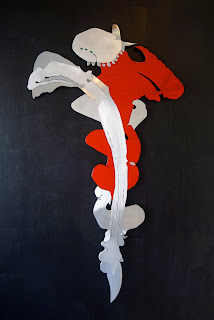 |
Michael Boles, To the Point, 2011. Aluminum, malachite,
and urethane. 40" x 72" x 1." Private collection.
|
It may be startling to discover that the terms real and
realism do not mean the same things, and in fact, have quite different
implications. Realism generally refers to the art historical definition,
meaning to artistically render an accurate representation or copy of a
preexisting object in space. Either painting or sculpture can imitate the
natural world and create a recognizable likeness of a thing (realism); however,
only sculpture can be real. Moreover, sculpture is always real. The
term real defines a three-dimensional object in space, not a representation of
it–which would be an illusion and not reality.
Sculpture extends beyond realism, moving from "a
depiction of a thing as it is" to being what it actually is, i.e., "a
sculpture." It is never an illusion, but always a real object existing in
space. Likewise, I reject the term "abstract sculpture," as
abstract denotes an idea separate from reality. My works make use of
abstract imagery, signs, and symbols, but that does not negate their existence
in real space. My sense is that the imagery is a part of a complete, real
object. While the imagery may refer to external ideas through iconography,
the unified work is self-referential. The whole sculpture and its imagery
exist before the viewer in the real world. I do not desire my sculptures to be
anything else.
I have defined an object existing in three dimensions as
being real; therefore, sculpture is real, but painting is not. Only a
painting's frame exists in reality; what is depicted, the illusion, is not
real. Minimalist sculptor Donald Judd explored this idea in his 1965 essay
"Specific Objects" (Donald Judd. "Specific Objects." In Art
in Theory 1900-2000: An Anthology of Changing Ideas, edited by Charles Harrison
and Paul Wood, 824-828. Malden, MA: Blackwell Publishing, 2003). Judd
identifies the plane of a painting as a form in itself. The best thing
painting can do is respond to its form, such as Frank Stella's stripe
paintings. Judd recognizes the problem between a painting's surface illusions
and its true external form (traditionally the rectangle). Judd writes,
"Anything on a surface has space behind it." That means one has
to understand even abstract painting as an illusion and in no way
reality. For Judd, sculpture was the only option in art: "Three
dimensions are real space. That gets rid of the problem of illusionism and
of literal space, space in and around marks and colors–which is riddance of one
of the salient and most objectionable relics of European art."
Our associations with paint and metal are not the
same. Paint implies surface and illusion. Metal, while also
possessing a surface, implies much more because it shares the viewer's
space. It does not depict reality (an illusion), but it is a real
object. Differentiating sculpture and painting lies in one's ability to
identify the characteristics of the art objects through the concepts of reality
and illusion.
Relief
sculpture is not new; it has existed in various materials for
centuries. My reliefs are composed with artistic techniques from across
time, but their purpose applies to the here and now and who I am as an artist
in the twenty-first century. My reliefs reject the traditionally accepted
notions of reality. They hold a space similar to a painting. They are displayed
on a wall, but there is no illusion. They maintain linearity while
pressing into the three-dimensional world. They are fundamentally what
they are, existing within the viewer's space. They utilize both two- and
three-dimensional elements, but are understood as real objects just like
freestanding sculpture. Viewers may find the combination of linear and
sculptural elements disconcerting, alluring, or both. Combining aspects of
two and three dimensions may generate a change of perception by forcing us to
reevaluate what we consider to be real. The relief sculptures I make
directly engage with multiple dimensions and the discourse of reality.
Either ostensibly planar or obviously 3D objects can share physical space with a viewer, but the point should be to share conceptual space. Glomming onto the existing western tradition can allow this, as can attempting the new. References to current events (The Raft of the Medusa) or shared fantasy worlds (Echo and Narcissus) feed a viewer's sense of involvement and therefore prompt the likelihood of provoking thought of enjoyment.
ReplyDeleteIn your recent critique, you lit into Koons, Gaga, & M. Cyrus. Reminded me of me and Jenny whats-her-name who put sayings mined form many sources on museum walls. It occurs to me that the Salon de R. crew were reviled by both critics and public. Only the caddis fly larvae remarked favorably on this work. Perhaps the view from the bottom of a stream bed in some way enhances our appreciation of the durable over the ephemeral. I wonder what the larva have to say re the sticker of James Surls? http://www.jamessurls.com/index.php#mi=2&pt=1&pi=10000&s=18&p=7&a=0&at=0
ReplyDelete